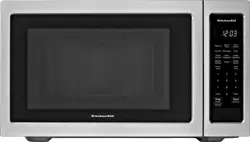Documents: Go to download!
User Manual
- User Manual - (English)
- Specification Sheet - (English)
- Warranty - (English)
- Installation Instructions - (English)
- INSTALLATION INSTRUCTIONS
- PARTS AND FEATURES
- MICROWAVE OVEN USE
- MICROWAVE OVEN CARE
- TROUBLESHOOTING
Table of contents
Use & Care Guide MICROWAVE OVEN
INSTALLATION INSTRUCTIONS
Unpacking
- Empty the microwave oven of any packing materials.
- Clean the inside with a soft, damp cloth.
- Check for damage, such as:
- a door that is not lined up correctly
- damage around the door, or
- dents on the interior or exterior of the microwave oven.
If there is any damage, do not operate the microwave oven until a designated service technician has checked it and made any needed repairs.
NOTE: To avoid damage to the microwave oven, do not remove microwave inlet cover. See the “Parts and Features” section.
Location Requirements
IMPORTANT: The control side of the microwave oven is the heavy side. Handle the microwave oven gently. The weight of the microwave oven is over 35 lbs (15.9 kg).
- Place the microwave oven on a cart, counter, table, or shelf that is strong enough to hold the microwave oven and the food and utensils you place inside it.
- The microwave oven should be at a temperature above 50°F (10°C) for proper operation.
NOTE: Some models can be built into a wall or cabinet by using one of the trim kits listed in the “Assistance or Service” section.
- Do not block the exhaust vents or air intake openings. Allow a few inches of space at the back and side of the microwave oven where the exhaust vents are located. Blocking the exhaust vents could cause damage to the microwave oven as well as poor cooking results.
- Make sure the microwave oven legs are in place to ensure proper airflow. If vents are blocked, a sensitive thermal device may automatically turn the microwave oven off. The microwave oven should work properly once it has cooled.
Electrical Requirements
Observe all governing codes and ordinances.
Required:
- A 120 V, 60 Hz, AC only, 15 or 20 A electrical supply with a fuse or circuit breaker
Recommended:
- A time-delay fuse or time-delay circuit breaker
- A separate circuit serving only this microwave oven
GROUNDING INSTRUCTIONS
- For all cord connected appliances:
The microwave oven must be grounded. In the event of an electrical short circuit, grounding reduces the risk of electric shock by providing an escape wire for the electric current. The microwave oven is equipped with a cord having a grounding wire with a grounding plug. The plug must be plugged into an outlet that is properly installed and grounded.
WARNING: Improper use of the grounding plug can result in a risk of electric shock. Consult a qualified electrician or serviceman if the grounding instructions are not completely understood, or if doubt exists as to whether the microwave oven is properly grounded.
Do not use an extension cord. If the power supply cord is too short, have a qualified electrician or serviceman install an outlet near the microwave oven. A short power supply cord is provided to reduce the risks resulting from becoming entangled in or tripping over a longer cord.
PARTS AND FEATURES
This manual may cover several different models. The model you have purchased may have some or all of the features shown here. The appearance of your particular model may differ slightly from the illustrations in this manual.
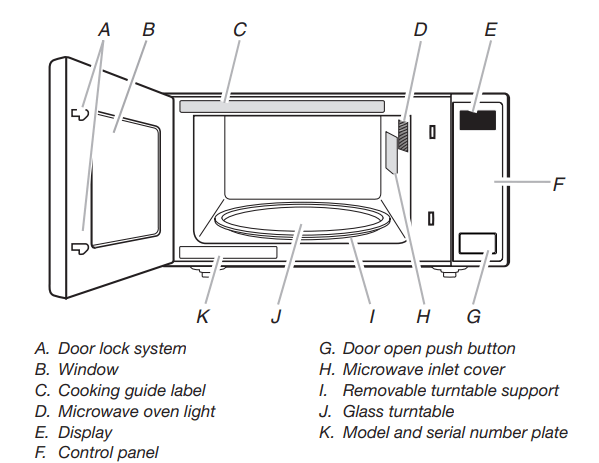
Turntable

The turntable can rotate in either direction to help cook food more evenly. For best cooking results, do not operate the microwave oven without having the turntable in place. See the "Assistance or Service” section to reorder any of the parts.
To Install:
- Place the support on the microwave oven cavity bottom.
- Place the turntable on the support.
Fit the raised, curved wedges in the center of the turntable bottom between the three spokes of the hub. The rollers on the support should fit inside the turntable bottom ridge
Microwave Oven Control

Display
When power is first supplied to the microwave oven, “0:00” will appear in the display. If the “0:00” appears in the display at any other time, a power failure has occurred. Reset the clock if needed. See the “Clock” section.
Function Icons

The icons light up in the display while their specific functions are being programmed. While the set function is operating, the icons flash until the program is over. The Control Lock icon remains lit – not flashing – while the control is locked.
When the microwave oven is in use, the display will show cook time remaining, and the function icons will flash. When the microwave oven is not in use, the display will show the time of day (if the clock is set) or Timer countdown (if the Timer is set).
Start
Start begins any function. If non-sensor cooking is interrupted by opening the door, touching Start will resume the cycle.
NOTE: To avoid unintentional operation of the microwave oven, a cooking function cannot be started if the microwave oven door has been closed for about 5 minutes. The word “door” will appear in the display until the door is opened and closed.
Add 30 Seconds
The Start Add 30 Sec keypad automatically starts the microwave oven at 100% power for 30 seconds, and it adds 30 seconds of cook time with each additional touch of the keypad.
Time may be added to any manual cooking cycle in 30-second increments, at the current power level, by touching Start Add 30 Sec during cooking.
NOTE: To avoid unintentional operation of the microwave oven, a cooking function cannot be started if the microwave oven door has been closed for about 5 minutes. The word “door” will appear in the display until the door is opened and closed.
Stop Cancel
Stop Cancel clears any incorrect command and cancels any program during cooking. It will not erase the time of day. The microwave oven will also turn off when the door is opened. Close the door and touch START to resume the cycle.
The Stop Cancel keypad is also used to lock and unlock the control panel. See the “Control Lock” section.
Tones
Tones are audible signals that cannot be turned off. These tones indicate the following:
One tone
- Valid entry
- Control Lock activated or deactivated
Two tones
- End of Convection Bake preheat
Three tones
- End of Timer countdown
Five tones
- End of cooking cycle
Clock
This is a standard 12-hour clock (12:00-11:59). The Clock cannot be erased. If the Clock is not set, “0:00” will remain in the display when the microwave oven is not in use.
To Set:
The microwave oven and Timer must be off.
- Touch CLOCK.
- Touch the number keypads to enter the correct time of day.
- Touch CLOCK.
Timer
The Timer can be set in minutes and seconds, up to 99 minutes seconds, and counts down the set time.
NOTE: The Timer does not start or stop the microwave oven.
Cook functions may be used while the Timer is counting down.
When the cook function is active in the display, touch TIMER to see the Timer countdown for about 5 seconds.
To Set:
- Touch TIMER.
- Touch the number keypads to enter desired time.
- Touch START. When the set time ends, “End” will appear in the display and the end-of-Timer tones will sound.
- Touch STOP CANCEL while the Timer is active in the display to cancel the Timer.
The time can be reset during the countdown by canceling Timer, and then repeating the above steps.
Control Lock
The Control Lock disables the control panel keypads to avoid unintended use of the microwave oven.
To Lock/Unlock Control: The microwave oven must be off. Touch and hold STOP CANCEL for about 3 seconds, until the tone sounds and the Control Lock icon appears in the display. Repeat to unlock.
The control lock icon will remain lit in the display until the control is unlocked.
If any keypad is touched while the control is locked, there will be no response from the control.
MICROWAVE OVEN USE
A magnetron in the microwave oven produces microwaves which reflect off the metal floor, walls, and ceiling and pass through the turntable and appropriate cookware to the food. Microwaves are attracted to and absorbed by fat, sugar, and water molecules in the food, causing them to move, producing friction and heat which cooks the food.
- To avoid damage to the microwave oven, do not lean on or allow children to swing on the microwave oven door.
- To avoid damage to the microwave oven, do not operate microwave oven when it is empty.
- Baby bottles and baby food jars should not be heated in microwave oven.
- Clothes, flowers, fruit, herbs, wood, gourds, and paper, including brown paper bags and newspaper, should not be dried in the microwave oven.
- Paraffin wax will not melt in the microwave oven because it does not absorb microwaves.
- Use oven mitts or pot holders when removing containers from microwave oven.
- Do not overcook potatoes. At the end of the recommended cook time, potatoes should be slightly firm. Let potatoes stand for 5 minutes. They will finish cooking while standing.
- Do not cook or reheat whole eggs inside the shell. Steam buildup in whole eggs may cause them to burst, requiring significant cleanup of microwave oven cavity. Cover poached eggs and allow a standing time.
Food Characteristics
When microwave cooking, the amount, size and shape, starting temperature, composition, and density of the food affect cooking results.
Amount of Food
The more food heated at once, the longer the cook time needed. Check for doneness and add small increments of time if necessary.
Size and Shape
Smaller pieces of food will cook more quickly than larger pieces, and uniformly shaped foods cook more evenly than irregularly shaped food.
Starting Temperature
Room temperature foods will heat faster than refrigerated foods, and refrigerated foods will heat faster than frozen foods.
Composition and Density
Foods high in fat and sugar will reach a higher temperature and will heat faster than other foods. Heavy, dense foods, such as meat and potatoes, require a longer cook time than the same size of a light, porous food, such as cake.
Cooking Guidelines
Covering
Covering food helps retain moisture, shorten cook time, and reduce spattering. Use the lid supplied with cookware. If a lid is not available, wax paper, paper towels, or plastic wrap approved for microwave ovens may be used. Plastic wrap should be turned back at one corner to provide an opening to vent steam. Condensation on the door and cavity surfaces is normal during heavy cooking.
Stirring and Turning
Stirring and turning redistribute heat evenly to avoid overcooking the outer edges of food. Stir from outside to center. If possible, turn food over from bottom to top.
Arranging
If heating irregularly shaped or different-sized foods, arrange the thinner parts and smaller-sized items toward the center. If cooking several items of the same size and shape, place them in a ring pattern, leaving the center of the ring empty.
Piercing
Before heating, use a fork or small knife to pierce or prick foods that have a skin or membrane, such as potatoes, egg yolks, chicken livers, hot dogs, and sausage. Prick in several places to allow steam to vent.
Shielding
Use small, flat pieces of aluminum foil to shield the thin pieces of irregularly shaped foods, bones, and foods such as chicken wings, leg tips, and fish tail. See the “Aluminum Foil and Metal” section first.
Standing Time
Food will continue to cook by the natural conduction of heat, even after the microwave cooking cycle ends. The length of standing time depends on the volume and density of the food
Cookware and Dinnerware
Cookware and dinnerware must fit on the turntable. Always use oven mitts or pot holders when handling because any dish may become hot from heat transferred from the food. Do not use cookware and dinnerware with gold or silver trim. Use the following chart as a guide, then test before using.
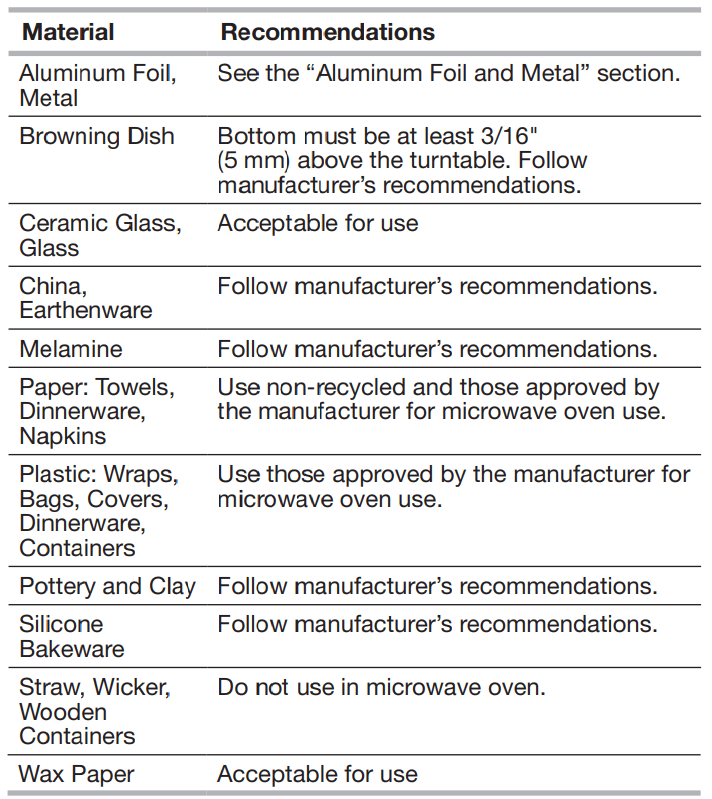
To Test Cookware or Dinnerware for Microwave Use:
- Place cookware or dinnerware in microwave oven with 1 cup (250 mL) of water beside it.
- Cook at 100% cooking power for 1 minute.
Do not use cookware or dinnerware if it becomes hot and the water stays cool.
Aluminum Foil and Metal
Always use oven mitts or pot holders when removing dishes from the microwave oven.
Aluminum foil and some metal can be used in the microwave oven. If not used properly, arcing (a blue flash of light) can occur and cause damage to the microwave oven.
OK for Use
Racks and bakeware supplied with the microwave oven (on some models), aluminum foil for shielding, and approved meat thermometers may be used with the following guidelines:
- To avoid damage to the microwave oven, do not allow aluminum foil or metal to touch the inside cavity walls, ceiling, or floor.
- Always use the turntable.
- To avoid damage to the microwave oven, do not allow contact with another metal object during microwave cooking.
Do Not Use
Metal cookware and bakeware, gold, silver, pewter, non-approved meat thermometers, skewers, twist ties, foil liners, such as sandwich wrappers, staples, and objects with gold or silver trim, or a metallic glaze, should not be used in the microwave oven.
Microwave Cooking Power
Many recipes for microwave cooking specify which cooking power to use by percent or name. For example, PL7 = 70% =Medium-High.
One of the power icons (see “Function Icons” in the “Display” section) will flash during manual cooking, depending on the power level of the cycle. To see the exact power level during a cooking cycle, touch POWER LEVEL. The display will briefly show the current power level, then will return to the cooking countdown.
Use the following chart as a general guide for the suggested cooking power of specific foods.
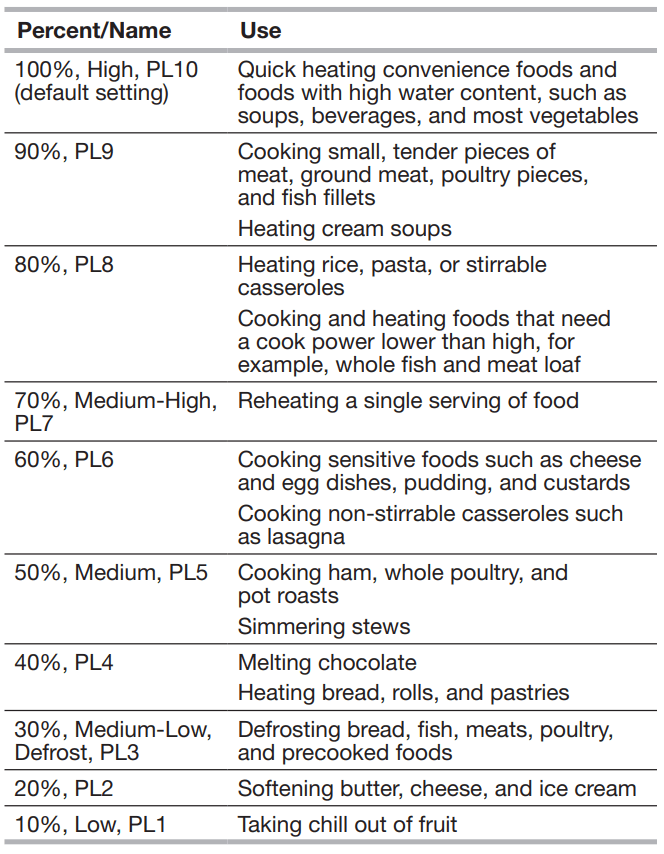
Manual Cooking
NOTE: To cook at 100% power, begin by touching the number keypads to enter cook time, then touch START.
To Use:
- Place food on the turntable and close the door.
- Touch COOK TIME. “00:00” will appear in the display. Enter the length of time to cook.
If cooking with 100% power, skip Step 3. - Touch POWER LEVEL.
The default power level PL10 will appear in the display. Enter the desired power level. See the “Microwave Cooking Power” section. - Touch START.
When the cycle ends, “End” will appear in the display and the end-of-cycle tones will sound. - Touch STOP CANCEL or open the door to clear the display.
Cooking in Stages
The microwave oven can be set to cook at different cooking powers for various lengths of time, up to 2 stages, which may include a defrosting stage. See the “Defrost” section to set the defrosting stage.
NOTE: If a defrosting stage is programmed, it will cycle first.
To Cook in Stages:
- Place food on the turntable and close the door.
- Touch COOK TIME. “00:00” will appear in the display. Enter the length of time to cook during the first stage.
- Touch POWER LEVEL, then enter the desired cooking power for the first stage. See the “Microwave Cooking Power” section.
- Repeat steps 2 and 3 for the second stage.
- Touch START.
Two tones will sound between stages.
When the cycle ends, “End” will appear in the display and the end-of-cycle tones will sound. - Touch STOP CANCEL or open the door to clear the display.
Cook time may be added in 30-second increments during the cycling stage by touching Start Add 30 Sec.
Favorite
Use the Favorite keypad to program, store, and recall the top three most frequently used manual cook programs. Each Favorite may have one or two stages (see the “Cooking in Stages” section). In the event of a power failure, the saved Favorites will have to be reprogrammed.
To Set FAVORITE:
- Touch FAVORITE.
"1" will appear in the display. Touch FAVORITE repeatedly to scroll through “2” and “3,” until the desired Favorite program number is displayed. - Touch COOK TIME, then enter the cook time.
- Touch POWER LEVEL, then enter the power level. If programming a second stage, enter the cook time and power level for that stage (see the “Cooking in Stages” section).
- Touch FAVORITE to save program
or
Touch START to begin the programmed cycle. The program will also be saved.
To Use FAVORITE:
- Place food on the turntable, and close the door.
- Touch FAVORITE repeatedly until desired program number appears in the display.
- Touch START.
When the cycle ends, “End” will appear in the display, and the end-of-cycle tones will sound. - Touch STOP CANCEL or open the door to clear the display.
Sensor Cooking
A sensor in the microwave oven detects humidity released from the food as it heats and adjusts the cook time accordingly.
Many sensor cycles require the covering of foods. Microwavesafe containers or steamers with loose-fitting lids are recommended. The loose-fitting lid allows enough steam to escape to be detected by the sensor. When covering foods with plastic wrap, be sure to leave a large enough vent opening to allow the steam to escape.
"SC” (sensor cook) will appear in the display during sensor cooking.
NOTES:
- The microwave oven should be plugged in for at least minutes.
- The microwave oven cavity and the exterior of the cooking container should be dry.
- The room temperature should not exceed 95°F (35°C).
- If the door is opened while the sensor is detecting moisture while “SC” appears in the display), sensing will stop and the program will be canceled.
Menu (sensor and non-sensor)
The following menu items are preprogrammed for quick and easy cooking/reheating.
For added convenience, the available/recommended amounts shown in the following chart are included on the Cooking Guide label. see the “Parts and Features” section for its location.)
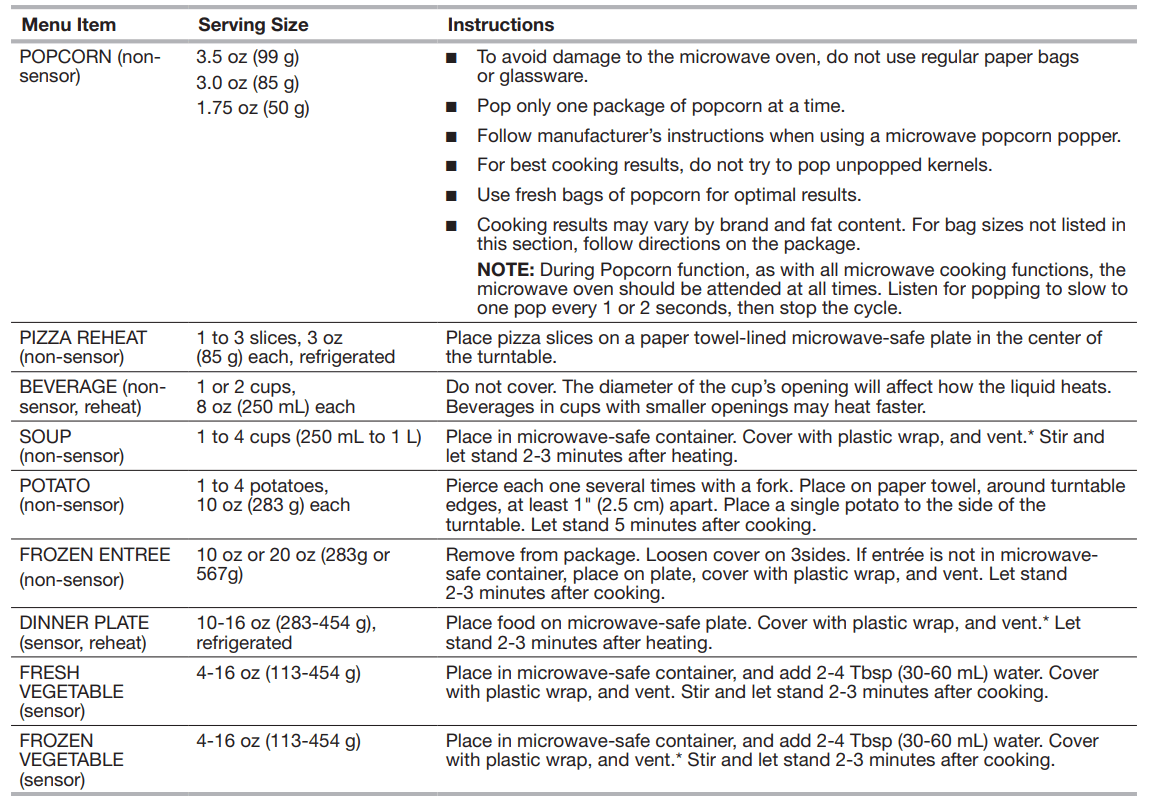
When covering foods, make sure the vent opening is large enough for the moisture to escape. This will allow the sensor to accurately determine cooking time.
To Use Non-Sensor Menu (Popcorn, Pizza Reheat, Beverage, Soup, Potato):
- Place food on the turntable, and close the door.
- Touch desired menu keypad.
The first programmed amount will appear in the display. Touch control keypad repeatedly to change quantity. See chart. - Touch START.
When the cycle ends, “End” will appear in the display and the end-of-cycle tones will sound. - Touch STOP CANCEL or open the door to clear the display.
To Use Sensor Menu (Dinner Plate, Fresh Vegetable,Frozen Vegetable):
- Place food on the turntable, and close the door.
- Touch the desired menu keypad. "SC” (sensor cook) will appear in the display.
- Touch START.
The microwave oven will start, and sensor cooking will begin. "SC” will remain in the display during cooking.
When the cycle ends, “End” will appear in the display and the end-of-cycle tones will sound. - Touch STOP CANCEL or open the door to clear the display.
Weight Defrost/Timed Defrost
The Weight Defrost feature’s preset programs can be used, the Timed Defrost feature can be used, or the microwave oven can be manually set to defrost.
- Unwrap foods and remove lids (for example, from fruit juice containers) before defrosting.
- Shallow packages will defrost more quickly than deep blocks.
- Separate food pieces as soon as possible during or at the end of the cycle for more even defrosting.
- Use small pieces of aluminum foil to shield parts of food such as chicken wings, leg tips, and fish tails. See the "Aluminum Foil and Metal” section first.
Weight Defrost
The Weight Defrost feature has preset times and cook powers for three categories: Meat, Poultry, and Fish. It should not be used for food that has been left outside the freezer for more than minutes, or for frozen ready-made food.CEL or open the door to clear the display.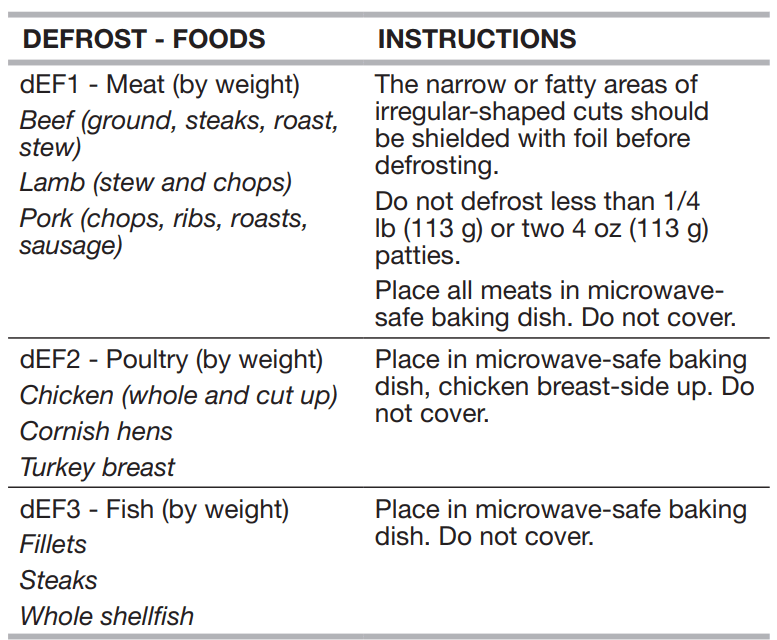
To Use Weight Defrost:
- Place food, uncovered, on the turntable and close the door.
- Touch WEIGHT DEFROST. dEF1” will appear in the display. Touch WEIGHT DEFROST a second time for “dEF2” or a third time for “dEF3” if defrosting poultry or fish. See chart.
To select your desired program, touch START or wait 5 seconds, and the prompt for entering weight will appear in the display. - Enter the weight.
Weight can be set from 0.3 lb to 6.3 lbs (136 g to 2.86 kg). - Touch START.
The display will count down the defrost time. The cycle may be interrupted briefly to turn food, if necessary, by opening the door. Close the door and touch START to resume the cycle.
When the cycle ends, “End” will appear in the display and the end-of-cycle tones will sound. - Touch STOP CANCEL or open the door to clear the display.
Timed Defrost
Timed Defrost does not have a preset program, but uses only 30%(PL3) cooking power.
To Use Timed Defrost:
- Place food, uncovered, on the turntable and close the door.
- Touch TIMED DEFROST.
“00:00” will appear in the display. - Enter the time in minutes and seconds.
- Touch START.
The display will count down the defrost time.
The cycle may be interrupted briefly to turn food, if necessary, by opening the door. Close the door and touch START to resume the cycle.
When the cycle ends, “End” will appear in the display and the end-of-cycle tones will sound. - Touch STOP CANCEL or open the door to clear the display.
To Defrost Manually: Follow directions in the “Manual Cooking” section, and use 30% cooking power. See the “Microwave Cooking Power” chart.
MICROWAVE OVEN CARE
General Cleaning
IMPORTANT: Before cleaning, make sure all controls are off and the microwave oven is cool. Always follow label instructions on cleaning products.
Soap, water, and a soft cloth or sponge are suggested unless otherwise noted.
MICROWAVE OVEN CAVITY
To avoid damage to the microwave oven cavity, do not use soap-filled scouring pads, abrasive cleaners, steel-wool pads, gritty washcloths, or some recycled paper towels.
To avoid damage to stainless steel models, rub in direction of grain.
The area where the microwave oven door and frame touch when closed should be kept clean.
Average soil
- Mild, nonabrasive soaps and detergents:
Rinse with clean water and dry with soft, lint-free cloth.
Heavy soil
- Mild, nonabrasive soaps and detergents:
Heat 1 cup (250 mL) of water for 2 to 5 minutes in microwave oven. Steam will soften soil. Rinse with clean water and dry with soft, lint-free cloth.
Odors
- Lemon juice or vinegar:
Heat 1 cup (250 mL) of water with 1 tbs (15 mL) of either lemon juice or vinegar for 2 to 5 minutes in microwave oven.
Microwave Inlet Cover
To avoid arcing and microwave oven damage, the microwave inlet cover (see the “Parts and Features” section) should be kept clean.
- Wipe with wet cloth.
MICROWAVE OVEN DOOR AND EXTERIOR
The area where the microwave oven door and frame touch when closed should be kept clean.
- Mild, nonabrasive soaps and detergents:
Rinse with clean water and dry with soft, lint-free cloth. - Glass cleaner and paper towels or nonabrasive plastic scrubbing pad:
Apply glass cleaner to towel, not directly to surface.
Stainless Steel (on some models)
To avoid damage to microwave oven door and exterior, do not use soap-filled scouring pads, abrasive cleaners, steel-wool pads, gritty washcloths, or some paper towels. Rub in direction of grain.
- Stainless steel cleaner (not included):
See the “Assistance or Service” section to order. - All-purpose cleaner:
Rinse with clean water and dry with soft, lint-free cloth. - Vinegar for hard water spots
CONTROL PANEL
- Sponge or soft cloth and water:
Dampen sponge with water and wipe panel. Dry with soft cloth. - To avoid damage to the control panel, do not use chemical or abrasive cleansers.
TURNTABLE
Replace turntable immediately after cleaning. Do not operate the microwave oven without the turntable in place.
- Mild cleanser and scouring pad
- Dishwasher
TROUBLESHOOTING
First try the solutions suggested here. If you need further assistance or more recommendations that may help you avoid a service call, refer to the warranty page in this manual
| If you experience | Recommended Solutions |
| Nothing will operate | Check the following:
|
| Microwave oven will not operate | Check the following:
|
| Microwave oven makes humming noise |
|
| Microwave oven door looks wavy |
|
| Turntable will not operate | Check the following:
|
| Turntable alternates rotation directions |
|
| Display shows messages |
|
| Display shows time countdown, but the microwave oven is not operating | Check the following:
|
| Cooking times seem too long | Check the following: Cooking power: See the “Microwave Cooking Power” section. Amount of food: Larger amounts of food need longer cooking times. Voltage: Have a qualified electrician check the electrical system in the home. |
| Radio, TV, or cordless phone interference | Check the following:
|
See other models: MGDB855DW YWED9600TA WVU17UC0JB KEBC278KBU KUDC03ITBL
